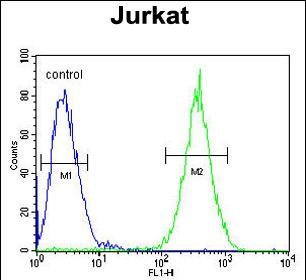SELPLG Antibody (C-term)
Affinity Purified Rabbit Polyclonal Antibody (Pab)
- SPECIFICATION
- CITATIONS
- PROTOCOLS
- BACKGROUND

Application
| FC, WB, E |
|---|---|
| Primary Accession | Q14242 |
| Other Accession | NP_002997.1 |
| Reactivity | Human |
| Host | Rabbit |
| Clonality | Polyclonal |
| Isotype | Rabbit IgG |
| Calculated MW | 43201 Da |
| Antigen Region | 379-405 aa |
| Gene ID | 6404 |
|---|---|
| Other Names | P-selectin glycoprotein ligand 1, PSGL-1, Selectin P ligand, CD162, SELPLG |
| Target/Specificity | This SELPLG antibody is generated from rabbits immunized with a KLH conjugated synthetic peptide between 379-405 amino acids from the C-terminal region of human SELPLG. |
| Dilution | FC~~1:10~50 WB~~1:1000 E~~Use at an assay dependent concentration. |
| Format | Purified polyclonal antibody supplied in PBS with 0.09% (W/V) sodium azide. This antibody is purified through a protein A column, followed by peptide affinity purification. |
| Storage | Maintain refrigerated at 2-8°C for up to 2 weeks. For long term storage store at -20°C in small aliquots to prevent freeze-thaw cycles. |
| Precautions | SELPLG Antibody (C-term) is for research use only and not for use in diagnostic or therapeutic procedures. |
| Name | SELPLG |
|---|---|
| Function | A SLe(x)-type proteoglycan, which through high affinity, calcium-dependent interactions with E-, P- and L-selectins, mediates rapid rolling of leukocytes over vascular surfaces during the initial steps in inflammation. Critical for the initial leukocyte capture. |
| Cellular Location | Membrane; Single-pass type I membrane protein. |
| Tissue Location | Expressed on neutrophils, monocytes and most lymphocytes |

Thousands of laboratories across the world have published research that depended on the performance of antibodies from Abcepta to advance their research. Check out links to articles that cite our products in major peer-reviewed journals, organized by research category.
info@abcepta.com, and receive a free "I Love Antibodies" mug.
Provided below are standard protocols that you may find useful for product applications.
Background
SELPLG is the high affinity counter-receptor for P-selectin on myeloid cells and stimulated T lymphocytes. As such, it plays a critical role in the tethering of these cells to activated platelets or endothelia expressing P-selectin. The organization of the SELPG gene closely resembles that of CD43 and the human platelet glycoprotein GpIb-alpha both of which have an intron in the 5-prime-noncoding region, a long second exon containing the complete coding region, and TATA-less promoters.
References
Elmas, E., et al. J. Cardiovasc. Electrophysiol. 21(11):1260-1265(2010)
Luan, S.L., et al. J. Pathol. 222(2):166-179(2010)
Bailey, S.D., et al. Diabetes Care 33(10):2250-2253(2010)
Russo, H.M., et al. Circ. Res. 107(3):388-397(2010)
Dick, D.M., et al. Mol. Psychiatry (2010) In press :
If you have used an Abcepta product and would like to share how it has performed, please click on the "Submit Review" button and provide the requested information. Our staff will examine and post your review and contact you if needed.
If you have any additional inquiries please email technical services at tech@abcepta.com.













 Foundational characteristics of cancer include proliferation, angiogenesis, migration, evasion of apoptosis, and cellular immortality. Find key markers for these cellular processes and antibodies to detect them.
Foundational characteristics of cancer include proliferation, angiogenesis, migration, evasion of apoptosis, and cellular immortality. Find key markers for these cellular processes and antibodies to detect them. The SUMOplot™ Analysis Program predicts and scores sumoylation sites in your protein. SUMOylation is a post-translational modification involved in various cellular processes, such as nuclear-cytosolic transport, transcriptional regulation, apoptosis, protein stability, response to stress, and progression through the cell cycle.
The SUMOplot™ Analysis Program predicts and scores sumoylation sites in your protein. SUMOylation is a post-translational modification involved in various cellular processes, such as nuclear-cytosolic transport, transcriptional regulation, apoptosis, protein stability, response to stress, and progression through the cell cycle. The Autophagy Receptor Motif Plotter predicts and scores autophagy receptor binding sites in your protein. Identifying proteins connected to this pathway is critical to understanding the role of autophagy in physiological as well as pathological processes such as development, differentiation, neurodegenerative diseases, stress, infection, and cancer.
The Autophagy Receptor Motif Plotter predicts and scores autophagy receptor binding sites in your protein. Identifying proteins connected to this pathway is critical to understanding the role of autophagy in physiological as well as pathological processes such as development, differentiation, neurodegenerative diseases, stress, infection, and cancer.



